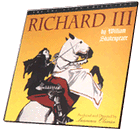

UK drama
1960
color 154 min.
Director: Laurence Olivier
CLV: $99.95 - available
2 discs, catalog # CC1342L
VHS: available from Home Vision Cinema
Laurence Olivier's Richard III was the last and best of the
trilogy of Shakespeare films directed by and starring the late
actor/filmmaker. Shot in 16 weeks during late 1954 and early 1955,
Richard III was the final, crowning glory of the British studio
system and the end of the great cycle of British films aimed at
international audiences that had helped spawn the careers of David
Lean, Michael Powell and Emeric Pressburger, Carol Reed, and Olivier
himself.
Richard III had the longest gestation period of any
of Olivier's Shakespeare films. Olivier originally had wanted to film
the play in the mid-1940s, concurrent with his successful portrayal of
the role at London's Old Vic; but Henry V, with its heroic
martial sentiments, seemed the more timely project. By 1954, Olivier
was no longer anxious to do the movie, having convinced himself that
he didn't have another large-scale Shakespeare movie in him to equal
Henry or Hamlet.
Up until Richard III,
Olivier's screen career of the 1950s had been relatively lackluster,
highlighted by a starring role in William Wyler's 1952 adaptation of
Theodore Dreiser's Sister Carrie, and a charismatic portrayal
of Macheath in Peter Brook's underrated The Beggars Opera
(1953). He otherwise had concentrated on the stage for much of the
middle-decade, and found great success as a producer as well as
leading man and director, most notably in Terence Rattigan's
Sleeping Prince (later filmed, with Olivier as co-star,
producer, and director, as The Prince and the Showgirl,
co-starring Marilyn Monroe) and the comedy Meet a
Body.
Richard III came about from Olivier's interest in
filming Macbeth the proposed production would have starred
Olivier, with Vivien Leigh as Lady Macbeth, and was to have been
filmed in authentic Scottish locations. But Alexander Korda, whose
London Film Productions was backing Olivier's production, had doubts
about Macbeth's appeal, and urged Richard on him instead, with
the promise that if it succeeded he would back
Macbeth.
Olivier first set about reintroducing himself to the
part over a period of weeks, and accomplished a startling screen
transformation. Vivien Leigh had hoped to portray Lady Anne, and was
bitterly disappointed when her husband selected Claire Bloom for the
part. (In compensation, Olivier arranged for her to star in The
Deep Blue Sea.)
A bigger problem was finding a substitute for
Bosworth Field. The real location wasn't usable, and no proper
replacement seemed available until Olivier's co-director and longtime
collaborator, Anthony Bushell, suggested a location near
Madrid. Spanish locations were not yet even the province of low-budget
westerns in 1954, but Olivier found his Bosworth Field near the
Escorial. The presence of mountains in the background scarcely
bothered anyone, and the availability of 500 Spanish extras helped
create the illusion of tens of thousands of troops on an affordable
budget.
The first day's shooting outside of Madrid had a profound
effect on Olivier's physical portrayal of Richard. A misplaced arrow
lodged in his leg rather than the armored shoulder of his horse, which
did as it was trained and fell upon the actor. Olivier continued with
the scene,
with blood pulsing out of his leg, making sure the
action was captured on film before seeking assistance. Fortunately,
the arrow hit him in his left leg, the one on which his Richard was
supposed to limp, and he no longer had to "act" the infirmity for the
part.
The ten-year delay in producing Richard III had served
Olivier well -- had he made the film in 1944, he would have had to
confine his casting to actors who were not in military service. But as
a 1954 production Richard III drew on the best of two
generations of English actors, including a quartet of acting knights
(Olivier, Richardson, Gielgud, and Hardwicke. gild veterans like
Laurence Naismith, John Laurie (Esmond Knight, and the younger players
lik icll;lel Gough and Patrick Troughton (who was also Olivier's
stand-in).
The television rights to Richard III were sold to
NBC in 1955 for $500,000, and the movie premiered on the network on
the same afternoon that it opened in theaters. The ratings services
later estimated that 62.5 million viewers -- more than the number of
people who had seen performances of the play since its premiere in
1592 -- had tuned in to watch an edited, black-and-white (there were
only 50,000 color sets in use), cropped version of Richard III,
interrupted by three General Motors commercial breaks.
Richard
III didn't perform well on its original release in America,
possibly because of the telecast, and didn't become a success in
America until it was reissued in 1966, when it broke box office
records in many cities. The movie subsequently fell out of
distribution, and managed to "lose" 23 minutes when it re-emerged in
the 1970. This Criterion Collection laserdisc release marks the first
presentation of the full-length, widescreen Richard III in
nearly three decades.
-- Bruce Eder
CREDITS
Produced and Directed by: Laurence Olivier
Production Designer:
Roger Furse
Screenplay Adapted by: Laurence Olivier and Alan
Dent
Associate Director: Anthony Bushnell
Art Director: Carmen
Dillon
Director of Photography: Otto Heller B.S.C.
Production
Supervisor: John Gossage
Editor: Helga Cranston
Music by: Sir
William Walton
TRANSFER
This edition presents the full-length complete version of
Richard III in its original VistaVision theatrical aspect ratio
of 1.85:1. This new digital transfer was created using a 35mm
composite print.




